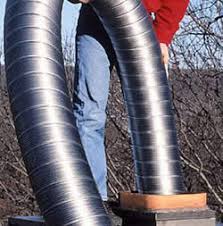What is a Chimney Liner? Do I Need a Chimney Liner?
Welcome to 2021. We hope this new year brings great health, and harmony to your homes.
Our dedication is to provide you with fireplace, chimney, and masonry knowledge as well as the highest integrity service. The intent of our monthly newsletter is to keep you up to date with the most current information. Our team is constantly undergoing training and we are observing all the regulations pertaining to COVID-19.
 Let’s talk about chimney liners:
Let’s talk about chimney liners:
A chimney liner is, in fact, a lining that goes in the flue of the chimney. The flue is a tunnel or passageway located within the chimney structure. A flue lining is made of clay, ceramic, or metal conduit and is intended to contain the burning products, and direct them to the outside atmosphere while protecting the chimney walls from heat and corrosion (similar to an exhaust for a car). Do you really need on? YES, YOU DO! (read why)
Do you really need a chimney liner?
Chimney liners create a clear and direct path for smoke to exit your home safely and efficiently. Without one, the chimney walls will eventually deteriorate, and smoke will be able to seep through any cracks. When your chimney cannot effectively release smoke outside, it greatly increases the risk of a chimney fire. The chimney liner is one of many chimney components that keeps your chimney working safely and smoothly. Check out our guide on How a Chimney Works to learn about the different parts of the chimney.
Are you interested in getting a chimney liner installed? Boston’s Best Chimney has been the community’s one stop chimney service company specializing in every aspect of chimney maintenance and repair since 1989. Click here or call (781) 893-6611 to get in touch with us.
How would I know if my chimney needs a new liner?
Unlined Flue
In the 1920s chimneys began to be built with clay tile liners. Most chimneys we encounter before this period are unlined and consist of just brick and mortar. This is not only concerning for carbon monoxide transmission, but also for heat transfer to neighboring construction materials. If your chimney is unlined, it should be lined for use.
Clay tile lined flue
Most chimneys built in this area after the 1920s are clay tile lined. Clay tiles are usually square or rectangular and in two-foot lengths. These sections are mortared together within the flue walls to create a barrier to the exposed brick and mortar. Over time, these sections, as well as the mortar between them, break down. This is mainly due to soot accumulation (high acid content) or moisture. Moisture can penetrate the brick (porous), come in from above (the flue opening) or from within with poor wood or gas fueled appliances. When there is a break or breach in the lining, the flue should be lined for use.
Chimney Liner Benefits
The most significant benefit of having a chimney liner is that it increases your home and family’s safety. When you use your heat, exhaust and carbon monoxide gets released so ensuring that the by-products of combustion are removed at all costs. Similarly, heat and smoke from your fireplace can enter the home during an improperly venting fire. This increases the residence time the smoke spends within the walls and creates soot buildup. Excess soot buildup is flammable and is how a chimney fire is formed.
There are various types of chimney liners on the market and most depend on how you are going to use your fireplace or heating flue. Whether you go from gas to wood burning or vice versa, you must install a new chimney liner appropriate for that type of fuel and use. The same rule applies to heating and hot water equipment because different materials are more suited for different types of fuel.
Of course, if you are unsure about your chimney liner’s status, get a chimney inspection as soon as possible. Click here or call (781) 893-6611 to contact us. Our trained staff can talk you through the differences and options for your specific needs. Please also note our special offers for the rest of January and February 2021.
The post What is a Chimney Liner? Do I Need a Chimney Liner? appeared first on Boston's Best Chimney.